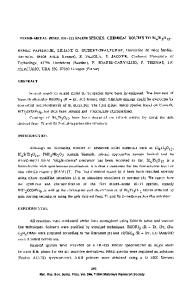Piezoelectric property investigation for sol-gel derived Bi 4 Ti 3 O 12 thick films
- PDF / 401,392 Bytes
- 11 Pages / 612 x 792 pts (letter) Page_size
- 65 Downloads / 396 Views
U14.1.1
Piezoelectric property investigation for sol-gel derived Bi4Ti3O12 thick films Hirofumi Matsuda, Sachiko Ito and Takashi Iijima Smart Structure Research Center, National Institute of Advanced Industrical Science and Technology, 1-1-1 Umezono, Tsukuba, Ibaraki 305-8568, Japan. ABSTRACT Strongly (117)-oriented Bi4Ti3O12 (BIT) thin (300 nm in thickness) and thick (900 nm in thickness) films were successfully synthesized from chemical solution and the piezoelectric and ferrelectric properties were studied. The chemical solution of Bi-acetate and Tiiso-propoxide dissolved in 2-methoxyethanol was spin-coated on Pt(111)/Ti/SiO2/Si(001) substrate, pyrolysed at 450-600 °C and annealed at 600 °C. On 300-nm-thick BIT thin film, Pt top electrodes were deposited through a metal mask by RF-sputtering. For longitudinal piezoelectric displacement measurement in partially unconstraint, 900-nm-thick BIT thick film, an array of disk-shape BIT capacitor cells with Pt top electrode layers standing on the Pt bottom electrode were fabricated by photolithography with the diameter of 80, 50, 30, 20 µm. To recover from plasma damage, post deposition annealing of 300-nm-thick BIT film and post lithograph annealing of 900-nm-thick BIT film were performed, respectively. Longitudinal piezoelectric displacement was measured directly from the Z-feedback and Z-error signals of an AFM piezoscanner head with application of ac electric field at 5 Hz and 1 kHz, respectively between the conductive cantilever tip contacted to the top Pt electrode and the bottom Pt electrode. By the removal of sidewalls of BIT, positive piezoelectric displacement response was measured. The maximum strain was about 0.1 % under bipolar drive (amplitude of 400 kV/cm or 4Ec). From the unipolar driven piezoelectric displacement, piezoelectric coefficient AFM-d33 was measured. The value of AFM-d33 increased to decreasing cell diameter and approached to a somewhat constant value of 12-13 pC/N. Considering the crystalline orientation, this value well corresponds to that of 20 pC/N which were reported previously in single crystal. The result of ferroelectric property measurement was rather contradictory. The values of remanent and saturated polarization Pr=20 and Psat=28 µC/cm2, respectively measured in 300-nm-thick BIT thin film were in good agreement with reported spontaneous polarization Ps=50 µC/cm2 along aaxis with the consideration of measured inclination angle of Ψ=58° between (200) and (117). In 900-nm-thick BIT thick film, on the other hand, measured values of Pr=6-7 µC/cm2 were much poorer than those of the thin film even with the consideration that measurement frequencies were 1 kHz in the thick film and 50 Hz in the thin film, although the films showed (117)-orientation. Measured piezoelectric response may reflect a specific single grain with favorable orientation in a cell, on the other hand, average value of ferroelectric property throughout a cell in the 900-nmthick BIT thick film having mixed orientation of (117) and (020).
U14.1.2
INTRODUCTION La-modif
Data Loading...











